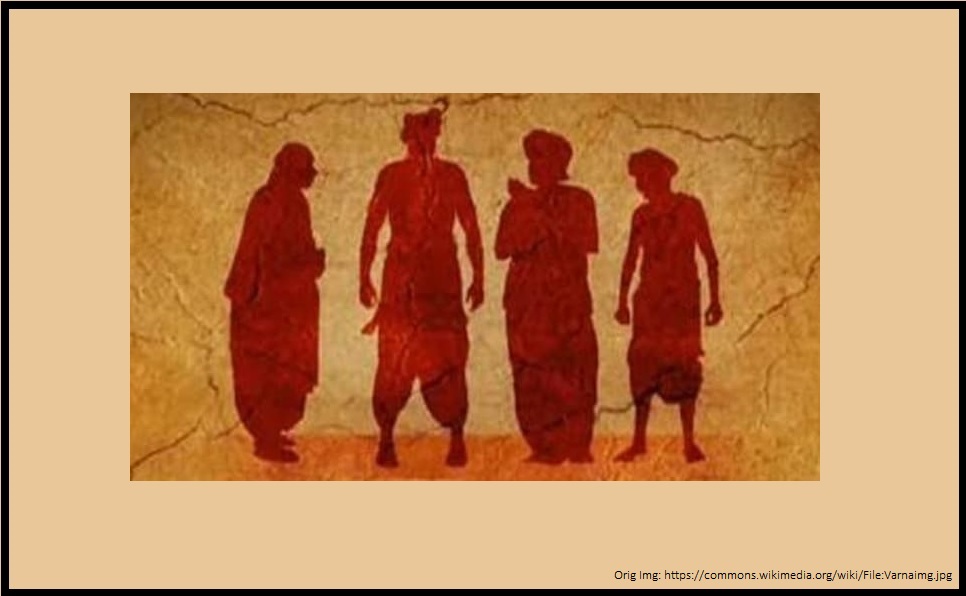In this article, we look into the varna system through Hindu scriptures, the varna system as practiced in ancient India and how the varna system was seen as a threat by invaders. Modern day caste is defined as having three attributes – hierarchical, endogamous and hereditary. Many intellectuals view the ancient Indian caste system as a social hierarchy divided into Brahmin, Kshatriys, Vaishya and Shudras. They also consider it as a form of exploitation wherein the upper caste exploits the lower caste. Some literature such as the Aryan invasion theory also claims that this caste system was created by Aryans (invaders) to exploit the natives.
The word caste is derived from Portuguese word ‘casta’ which means lineage and was first used in mid-16th century Europe. It was used to describe the Portuguese and Europeans social structure of Pope/Cardinals, Aristocracy, Merchants and Peasants. There is no equivalent word or concept in Hindu scriptures and no identical structure either recorded or promoted in Hindu Scriptures. The word that is mentioned in Hindu scriptures is varna, which is different from caste. The Sanskrit word varna means type, order, color or class. It more precisely means variations/variety. Unlike the word caste, the word varna clearly doesn’t mean a hereditary, hierarchical, endogamous or social class structure.
Varna in Hindu scriptures
Varna in Rigveda:
The four Varna system, which consists of Brahmin – the priestly class i.e. intellectuals, Kṣhatriya – the warrior class, Vaishya – the mercantile and farming class and Shudra – the worker class, first occurs in Purusha Sukta of the Rigveda X.90.12. The hymn describes the entire universe in the form of a human being, a Cosmic Person called the “Purusha”

Translation (TH Griffith):
The Brahmin was his mouth, of both his arms was the Rajanya (synonym for Kshatriya) made. His thighs became the Vaishya, from his feet the Shūdra was produced.
The key thing to note in the above verse is that varna is shown as symbolic representation of body parts of Purusha and unlike the popular opinion it doesn’t mention different varnas being born from different parts of Purusha. There is no concept of hierarchy, superiority or domination of any particular Varna.
From the perspective of above Shloka, each varna constitutes a necessary part of the whole (Purusha in form of Cosmic being) and all are mutually interdependent. Each is a manifestation of the same Divine consciousness working in humanity but reflects a deep appreciation of the interdependence and mutual interaction out of which life operates. Just as the human body remains healthy and strong only when all parts of the body function in harmony. Similarly human society remains healthy and strong when all varnas – Brahmana, Kshatriya, Vaishya and Shudra function in harmony.
Varna in Bhagavad Gita:
The four Varnas are also mentioned in Bhagavad Gita Chapter 4 verse 13 and Chapter 18 verse 41 by Lord Krishna

Translation:
The four Varnas were created by me according to people’s qualities and actions. Although I am the creator of this system, know me to be the non-doer and eternal.
In the above verse, Lord Krishna mentions that he had created Varnas based on people’s qualities (Guna – Satva, Rajas and Tamas) and actions (Karma). Note that the division is not based on birth but only based on qualities and occupation (actions).

Translation:
O Parantap! The duties (actions) of Brahmins, Kshatriyas, Vaishyas and Shudras are distinguished based on qualities (Guna – Satva, Rajas & Tamas) born out of nature
In the above verse as well, Lord Krishna mentions that the duties of Brahmins, Kshatriyas, Vaidhyas and Shudras are distinguished based on people’s qualities (Guna – Satva, Rajas and Tamas). Again there is no division based on birth.
Varna system in ancient India
The morality and dedication toward duties by each varna can be seen from what Shri Aurobindo, one of the greatest Hindu saints, recorded about the ancient India society
Shri Aurobindo records:
The spirit of ancient India was aristocratic; its thought & life moulded in the cast of a high & proud nobility, an extreme & lofty strenuousness. The very best in thought, the very best in action, the very best in character, the very best in literature & art, the very best in religion and all the world well lost if only this very best might be attained, such was the spirit of ancient India. The Brahmin who devoted himself to poverty & crushed down every desire in the wholehearted pursuit of knowledge & religious self-discipline; the Kshatriya who, hurling his life joyously into the shock of chivalrous battle, held life, wife, children, possessions, ease, happiness as mere dust in the balance compared with honor & the Kshatriya dharma, the preservation of self-respect, the protection of the weak, the noble fulfillment of princely duty; the Vaishya, who toiling all his life to amass riches, poured them out as soon as amassed in self-forgetting philanthropy holding himself the mere steward & not the possessor of his wealth; the Shudra who gave himself up loyally to humble service, faithfully devoting his life to his dharma, however low, in preference to self-advancement & ambition; these were the social ideals of the age.
Thus, the Brahmins dedicated their life for the pursuit of knowledge and religious self discipline even if it meant living in poverty and crushing their personal desire. The Kshatriyas hurled themselves with joy into the battlefield for self respect, protection of the weak and fulfillment of their duties without worrying about wife, children and possessions. Vaishya poured his hard-earned riches for philanthropy. Shudra faithfully devoted his life to service and dharma sacrificing his ambitions and self-advancement.
Varna system in modern context
In modern context, the division mentioned in Rigveda would translate as under:
Brahmin – the priestly class or intellectuals. This would include priests, teachers of scriptures, scientists, policy makers and other similar positions as well as advisors of our leaders.
Kshatriya – the warrior class. This would include our leaders, armed forces,and police force responsible for protection of citizens.
Vaishya – the mercantile and farming class. This would include farmers and self-employed people running business or firms (providing employment to others).
Shudra – the worker class. This would include all people (workers) doing jobs that help run the society e.g. engineer, managers, bankers, artisans, laborers, factory workers etc.
Varna system seen as threat by invaders
India has been through a phase of both Islamic & Christian Imperialism. The Brahmins and the varna system were seen as a threat by the invaders. The Brahmins and the decentralized social organization (varna system a.k.a caste system) had served the Hindu state as the line of defense whenever the state broke down under foreign invasion. The first foreign invader – Alexander who was turned back by stiff resistance offered by the small republic of Punjab concluded that the Indians fought so bravely because they were guided by Brahmins. Centuries later Islamic invaders also identified Brahmins as the source of Hindu strength. Francis Xavier arrived at Goa in 1542 and surveyed the scene in India for several years with an intent to convert India natives to Christians with the help of Portuguese arms. He concluded that Chrisitanity will not likely make a way in the country as long as the Hindus had Brahmins and the caste system (varna system) to teach and protect them. These perceptions were shared by later Imperialists – The Christian missions, British administrators and the communists. In 1844, Joseph Roberts of the Royal Asiatic Society of great Britain in his address to gathering of lead missionaries in Madras also mentioned that caste (varna) is the great barrier between the Pagans (Indian natives) and Christ and that it is advisable to call attention to this difficult and painful subject.
Conclusion
Thus, the divisions of the Varna system were not hierarchical or hereditary (by birth). The Varna system was a wonderful system of ancient India society in which all divisions worked in harmony with great morality and dedication. It was back-bone of society in ancient India and was seen as a threat by foreign invaders. To control and subjugate the native population, it was essential for the invaders to break this back-bone of Indian society. The current narrative of the caste system that we see today was set up by European invaders to control and subjugate the native population. They also came up with multiple narratives targeting the varna system and Indian culture for e.g. Aryan invasion.
References:
https://msrvvp.ac.in/ved-vidya/24/19_Eng._Priyanka_pande_24.pdf
https://www.indica.today/long-reads/why-varna-is-not-caste/
https://www.sacred-texts.com/hin/rigveda/rv10090.htm
Bhagavad Gita – 4-13 , 18-41
Caste, Conversion, A Colonial Conspiracy – Pt Satish K Sharma


